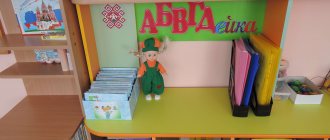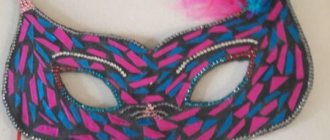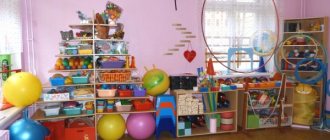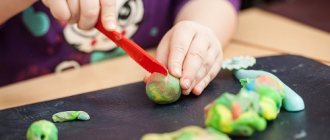Annual report on circle work
Yulia Anatolyevna Gudozhnikova
Annual report on circle work
Report on the circle “We are inventors”
for the 2019-2020 academic year
In the 2019-2020 academic year, with the children of the preparatory group, I began work on the experimental research activity “We are inventors”
.
The circle was attended by 10 students, which is 48% of the total number of children in the group. Classes in the circle were conducted in a playful way, using fairy tales, 2 times a week, for 30 minutes.
Club work was carried out in accordance with regulatory legal acts in the field of education. Regulations on the creation of circle work in MDOU , Charter of MDOU. The work in the circle was carried out on the basis of an order from the head of the MDOU.
The purpose of this program is to create conditions for the formation of the foundations of a holistic worldview of a child of senior preschool age through physical experimentation, to promote the development of children's cognitive activity, curiosity, the desire for independent knowledge and reflection, the development of observation, the ability to compare, analyze, generalize, the development of children's cognitive interest in the process of experimentation, establishing a cause-and-effect relationship, the ability to draw conclusions, developing attention, visual and auditory sensitivity, creating the prerequisites for the formation of practical and mental actions.
The main tasks that I set for this academic year were the following:
1. Expanding children’s ideas about around them through familiarization with basic knowledge from various fields of science.
2. Development in children of an understanding of the chemical properties of matter (isolation of a substance by sedimentation and filtration, development of an understanding of basic physical phenomena (magnetic and terrestrial gravity, electricity, reflection and refraction of light, evaporation, magnetism, gravitational force, etc.).
3. Development of ideas about the properties of water, sand, clay, air, stone.
4. Development of elementary mathematical concepts of measurement - as a method of measuring volume, mass, length, and standards for measuring length.
5. Development in children the ability to use instruments - assistants when conducting experiments (magnifying glasses, microscope, cup scales, hourglass, ruler, measuring tape, binoculars)
6. Development of mental abilities in children.
7.Development of thinking abilities: analysis, classification, comparison, generalization.
8. Formation of experience in complying with safety regulations when conducting physical experiments.
9. Development of an emotional and value-based attitude towards the world around us .
During this academic year, experiments were conducted on the topics: “Plants”
,
“Soil”
,
“Stones”
,
“Air”
,
“Water”
,
“Magnets”
,
“Light and Mirror”
.
Forms and methods of organizing teaching activities.
Depending on the assigned tasks, various teaching methods and techniques are used in the lesson.
The main form of work is classes : travel classes, experimental classes, excursion classes, but targeted walks, cyclic observations, and project activities are also organized. Thanks to them, the motivation of the child’s personality to learn is purposefully formed and developed.
Basic methods: problem-based, conversation and targeted observation of the experimental activities of children. The experiment must meet the following conditions: maximum simplicity of the design of devices and rules for handling them, trouble-free operation of the devices and unambiguity of the results obtained, showing only the essential aspects of the phenomenon or process, clear visibility of the phenomenon being studied , the opportunity for the child to participate in a repeat demonstration of the experiment.
Most of the classes are complex in nature and include different types of children's activities: educational and gaming, communicative and dialogue, experimental and research.
Methods of stimulation and motivation:
• questions from the teacher that encourage children to pose a problem.
• questions that help clarify the situation, put forward a hypothesis and understand the meaning of the experiment, its content and natural pattern;
• a method that stimulates children to communicate: “Ask your friend about something, what does he think about it?”
Game methods: experimental games allow you to verify the reliability of physical and natural phenomena and patterns. The work uses a variety of components of gaming activity in combination with other techniques: questions, instructions, explanations, clarifications, demonstration (didactic games “Good-bad”
,
“Find a pair”
,
“Find out by taste”,
etc.;
games with sand, water, magnets and magnetic letters; colored, carbon paper, cardboard, etc.; story games “Atelier”
,
“River Journey”
,
“Builders”
,
“Drowning - Not Drowning”
, etc.)
Practical:
• actions with a magnifying glass, measuring instruments, pouring liquids, pouring bulk materials, experiments “Properties of water”
,
“Sunny bunnies”
,
“We are magicians”
with a magnet, etc.) allow you to independently master the methods of cognitive activity
Elementary experience is the transformation of a life situation, object or phenomenon in order to identify hidden, not directly presented properties of objects, establish connections between them, reasons for their change, etc.
Dramatization method: when a child takes on the role of Dunno-Why, a laboratory assistant or a scientist.
Verbal teaching method:
Teacher's stories ( “What can be made from paper?”
,
“What is clay for?”
, reading fairy tales
“A flower - a flower of seven”
,
“Twelve months”
,
“How people offended a river”
, etc.)
The main task of this method is to create in children vivid and accurate ideas about events or phenomena. The story affects the mind, feelings and imagination of children, encourages them to share their impressions.
Children's stories (children tell what kind of experiment they would like to carry out, what material will be needed for this, in what sequence they will carry it out; share impressions about the natural phenomena they saw; write short stories about the results obtained, etc.)
This method is aimed at improving the knowledge and mental and speech skills of children.
Conversations ( “Water in the life of the inhabitants of the earth”
,
“How do people use the properties of wood”
,
“Why do people get sick?”
etc.)
Conversations are used to clarify, correct knowledge, generalize and systematize it.
The observation method refers to visual methods and is one of the main, leading methods of preschool teaching. Depending on the nature of cognitive tasks in practical activities, observations of various types are used: experimental diagrams, tables, illustrations of natural and physical phenomena make it possible to simplify the understanding of complex phenomena in preschool level.
– recognizing nature, during which knowledge is formed about the properties and qualities of objects and phenomena (experiments “It burns - it doesn’t burn”
,
“What color is the water?”
,
“Floats or sinks”
, etc.)
– for the change and transformation of objects (ice-water, water-steam, seed-sprout, etc.)
Older preschoolers develop fairly correct and complete pictures of the nature around them . Work with children should be structured taking into account their age characteristics.
To make it easier to find the necessary experiences and experiments, it is necessary to systematize the description of the experiments included in the long-term planning in a card index.
The implementation of the assigned tasks is carried out in three main forms:
-classes
-independent activities of children
-joint activity of an adult and children, as well as a child with a peer
During the lesson, the teacher must arouse interest in the content being studied in order to encourage the child to engage in independent activities.
In the process of independent activity, children learn ways of cognitive activity. "How to find out? What do you need to do to make sure? What will happen if?
And then, in joint activities, consolidate previously acquired knowledge and ideas.
Detailed description of work .
The lesson is a traditional form of working with children in kindergarten. The teacher must arouse and maintain children's interest in the topic being studied in order to solve all the assigned tasks.
And the experiments remind children of “tricks”
, they are unusual, and, most importantly, the children do everything themselves and experience a feeling of joy from their small and large
“discoveries
.
Children themselves give unusual names to some activities if they have discovered something new for themselves - “Activities - discoveries”
, were surprised a lot -
“Surprise Classes”
.
After classes, children have many questions based on a cognitive motive.
They are interested, for example, in why the water level in the aquarium drops?
Why do mittens become dry after lying on the radiator? Where does the water go?
You should not rush to answer, but you should encourage children to find it on their own. To do this, it is necessary to carefully consider the organization of the developmental environment, because the process of cognition is based on curiosity and inquisitiveness, which in turn arise and are realized in conditions of novelty and unusualness of the field of activity.
The criterion for the effectiveness of children's experimentation is not the quality of the result, but the characteristics of the process, that is, the child’s ability to determine the goal, ways to achieve it, and evaluate the result obtained.
Conclusion:
Children have mastered the means of cognitive activity; methods of action, inspection of objects; expansion of cognitive experience; developed the ability to independently “extract”
necessary information; formulated their cognitive interest in verbal form using conventional symbols; use acquired knowledge, skills and abilities in gaming activities; have an idea of some environmental factors (light, air temperature; water - transition to various states; air; soil); have an idea of the importance of water and air in human life; have an understanding of the properties of soil and its constituent sand and clay, and have experience in complying with safety regulations when conducting physical experiments.
Having analyzed the children’s knowledge at the beginning and end of the year, I can conclude that the level of development of cognitive processes in children has increased.
I would like to note the positive results of the work carried out this academic year . I believe that the use of children's experimentation in preschool age is an effective and necessary method for developing children's research skills, cognitive interest, and increasing the amount of knowledge, skills and abilities. General observation allows me to conclude that I will continue my work in this direction .
Club work report
Report of the circle work “Visiting a fairy tale” by group teacher Kuzor L.A. for the period
24.09.13 – 28.05.14
Program content
The content of the entire club program is subject to a single principle of expanding and deepening knowledge, action from simple to complex.
In the very first days of the circle, I conducted a diagnosis of the children, which included the following parameters:
Diagnostic card.
High level (18-21 points) – the child shows a steady interest in theatrical art and theatrical activities. Understands the main idea (of a literary work). Able to empathize with characters and convey emotional states, independently find expressive means of transformation. Possesses intonation-figurative and linguistic expressiveness of artistic and creative activities.
Average level (11-17 points) – shows emotional interest in theatrical art and theatrical activities. Has knowledge of various types of theater. Understands the content and main idea of a literary work. Has knowledge about the emotional states of characters and can demonstrate them in work with the help of a teacher. Actively participates in various types of creative activities.
Low level (7-10 points) – low-emotional, shows interest in theatrical art only as a spectator. It is difficult to define different types of theaters. Knows the rules of behavior in the theater. Understands the content of the work.
According to the results of this diagnosis, at the beginning of classes, all children had a low level of mastery of theater skills.
It should also be said that during the lessons we became acquainted with the concept of “facial expression”, “gesture”, and by acting out simple sketches, the children mastered the simplest skills of working with these acting principles. A number of classes were also held where children learned about what theater is and about theater workers.
First of all, according to the work plan for this period of time, I introduced the children to such types of puppet theaters as: tabletop, finger theater, mask theater. Introduced me to the theater table screen.
I devoted the next series of classes to working with finger theater. The children quickly learned the principle of working with this type of theater. Finger theater involves working on a theater screen. We enjoyed performing short monologues, thereby strengthening our finger theater skills. This type of theater is the easiest to learn and teach the principles of working with it.
The next type of theater to which we decided to devote more than one lesson is tabletop. I would like to note that the technique of working with this type of theater is difficult in that children have difficulty orienting themselves on the plane of the table in relation to the audience. Initially, I taught mastery of the technique of working with this type of theater by personal example, and then by subgroup method. 4 people sat at the table and acted out fairy tales. Thus, I solved two problems at the same time:
— building dialogues from simple to complex;
— gradual mastery of skills in working with a tabletop theater.
We played the game “Recognize the mood by facial expressions and gestures,” thereby demonstrating the basics of acting.
The diagnostic results are encouraging.
Diagnostic card
At the end of this training period, according to the diagnosis, I received the following results in the children’s mastery of theatrical skills:
60% - children have an average level of assimilation. 40% - low with a tendency towards average
Conclusion
Theater classes help children cope with complexes, self-doubt, and stress. They contribute to the development of dialogical speech and fine motor skills in children. Classes in the theater club give children aesthetic pleasure and gain knowledge in the field of theatrical culture. The diagnostic results confirm this.
Expected skills of children
1. Orientate yourself in space.
2. Be able to remember the words and actions given by the teacher
3. Perform simple physical actions freely and naturally.
4. Be able to change the pitch and strength of the voice according to the teacher’s instructions.
Expected Result
Revealing children's creative abilities (intonation pronunciation, emotional mood, facial expressiveness, imitation skills).
Development of psychological processes (thinking, speech, memory, attention, imagination, cognitive processes).
Personal qualities (friendships, partnerships; communication skills; love for animals).
Diagnostic card (at the beginning of the year) 0,1,2
This might interest you:
- Report on the work done in the senior mixed-age group Report on the work done in the senior mixed-age group of the Rodnichok kindergarten for September-December 2020 academic year. Educator: MBDOU "Kindergarten "Rodnichok" Gordeeva Lyudmila Yurievna...
- Report on the work of the summer school camp Report on the work of the summer health school camp “Sounding Voices” at the Municipal Educational Institution “Secondary School No. 49” for 1 shift 2020 Information about the camp Children’s health camp…
- Report of the physical education instructor Ivacheva YV for the academic year Report of the physical education instructor Ivacheva YV for the 2015-2014 academic year. year Self-education topic: “The use of health-improving, corrective gymnastics in the physical activity of children...
- Report Traffic Rules MKDOU "BOGUCHARSKY COMBINED KINDERGARTEN "SMILE" Report "Road Rules" Educator: Matvienko L. A. 2nd junior group No. 1 Boguchar 2014 Kindergarten…
- Report on the work of the MO Report on the work of the MO teachers of art, life safety, labor and physical education for the first half of the 2015-2014 academic year. During the reporting period, three methodological associations were carried out...





